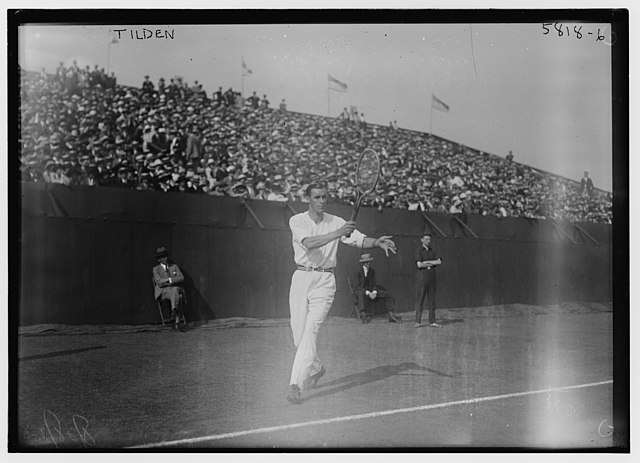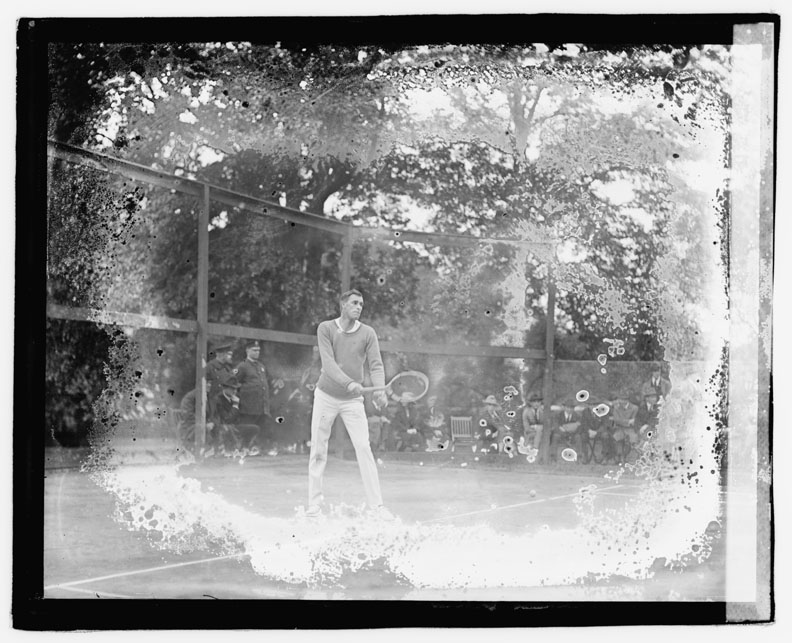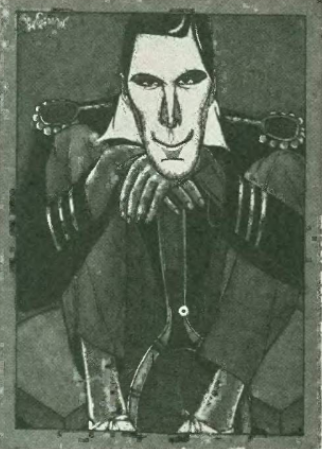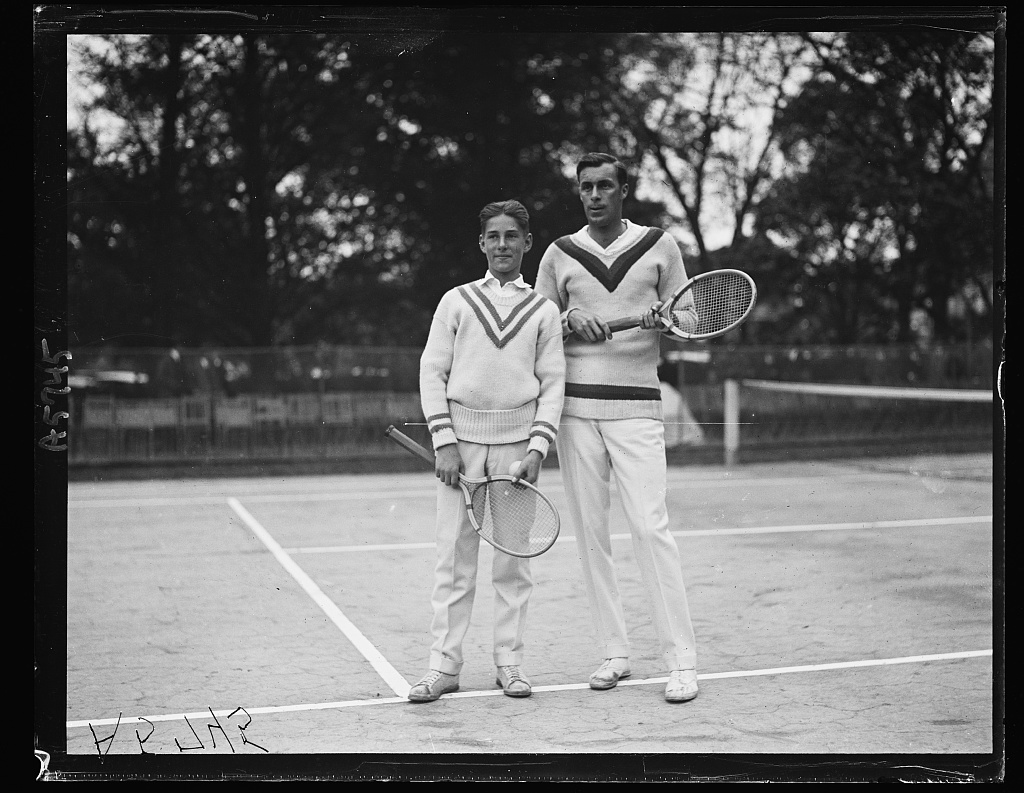I’m counting down the 128 best players of the last century. If this is your favorite player, Congrats! (or: I’m sorry.)
* * *
Bill Tilden [USA]Born: 10 February 1893
Died: 5 June 1953
Career: 1912-46
Played: Right-handed (one-handed backhand)
Peak rank: 1 (1920)
Major singles titles: 10 (1 World Hard Court title; 3 pro majors)
Total singles titles: 156
* * *
Bill Tilden reversed the usual progression of a prominent tennis figure. First, he coached. As he helped youngsters learn the game, he worked out an overarching theory of how tennis should be played. Then–and only then–did he become a national champion.
That isn’t to say that Tilden couldn’t manage more than one thing at a time. Throughout the 1920s, Tilden dominated American tennis like no player before or since. He competed, he wrote, he organized tournaments, he mentored, he squabbled with the national federation–in the phrase of the day, Tilden was tennis.
Many of those things came naturally to the lanky six-footer who came to be known as Big Bill. Oddly enough, his tennis game did not.
In 1926, the New Yorker profiled Tilden’s dogged quest to become as big a star on stage as he was on court. “I have been told I’m pretty bad as an actor, but once I was a pretty bad tennis player, too,” he said. “It required twenty-one years for me to win a championship.”
Big Bill was exaggerating, but only just. Growing up in Philadelphia, he chased fads, swinging from the baseline one year, rushing the net another. His older brother, Herbert, was considered a better prospect. At the University of Pennsylvania, Bill was so far down the ladder of the school tennis team that he rarely played.
He was, however, fascinated by the game. He started giving clinics to younger players, where he realized that he often lacked answers to basic questions about grips, spin, and shot selection. There were few professional coaches in those days, and technique was still evolving into its modern form. It wasn’t a matter of looking up the answers and reporting back to the kids at the next lesson. He had to work out the solutions himself.
So that’s what he did. Inevitably, his own play improved, and he began thinking in terms of a complete game–in theory and in practice. Tilden had little else to do. He didn’t care much for school, and when he was 22, both Herbert and his father died. Tennis served as both an outlet and a necessary distraction.
“He suddenly determined to be a good tennis player,” said one of Bill’s first protégés, Carl Fischer. “Make no mistake, though, that but for this incredible determination, you never would have heard of Bill Tilden. Nobody ever worked so hard at anything as he did at tennis.”
* * *
By 1918, Tilden’s efforts paid off. He reached the final of the US National Championships, where he lost to defending champion Robert Lindley Murray. He matched the feat the following year. Bill Johnston, an undersized Californian with a devastating forehand, stopped him in his second attempt at the title.
The two-time finalist was 26 years old. He was increasingly well-known in tennis circles, not just for his play–he partnered Vinnie Richards to win the national doubles title in 1918–but for his writing as well.
Everything Tilden worked out as a coach finally came together in a unified theory of the game. He published an essay for American Lawn Tennis in March 1919 called “Variety Is Essential for Tennis.” Much of it now reads as clichéd, even stodgy, but only because coaches and commentators have been echoing the same lines for the hundred years since.
The whole secret of tennis success outside of actual stroke perfection (which any one can learn in time), is to always keep mentally alert. “Use the bean” at all times and under all conditions. When you guess wrong, you will look a fool and get called “bonehead”; but never mind, for you gain more than you lose, even if no recognition is taken of it.
Big Bill’s judgment was that most players didn’t think any further ahead than the execution of a single stroke. They didn’t consider the purpose of their shot, or how it might affect the man across the net. Tilden was probably the first advocate of playing to an opponent’s strength. Not only did it threaten to break down a foe’s game entirely, it acknowledged that most players knew how to cover their weaknesses.
In articles like this, along with books such as The Art of Lawn Tennis and Match Play and the Spin of the Ball, the American champion recorded one timeless adage after another. Most points end in errors, so a savvy tactician keeps the ball in play and lets his opponent make mistakes. The crucial point of the game is 15-30 or 30-15. The key juncture in the set is the seventh game, which is still sometimes known as the “Tilden game.”
Above all: Practice is serious business. “My idea of intensive practice,” Tilden wrote in Match Play, “is to pick out one stroke and hammer away at that shot until it is completely mastered.”
When it comes to practice, preparation, diet, equipment, all that stuff, it’s usually reasonable to assume that players have gotten more dedicated, more precise in the last hundred years. Tilden with a new stroke is the exception. Today’s stars talk about training blocks: a few weeks carved out of the tournament schedule. Well, after losing the 1919 final to Johnston, Big Bill decided he needed a better backhand. He moved to Rhode Island, took over one of the country’s few existing indoor courts, and drilled that goddamn backhand for six months.
* * *
The irony of it is, Tilden’s backhand wasn’t that bad. We don’t have authoritative records for much of his career, but one source gives him a 65-4 record for 1919. Bill called his backhand “a shining mark at which anyone could plug away with impunity,” but few of his opponents seemed to realize it. Like most players of his day, he relied on a slice on that wing. It was not an easy weakness to exploit, if indeed it was a weakness at all.
The shot let him down only against Johnston–“Little Bill” next to his taller rival. The New York Times that year called Johnston’s forehand “unquestionably the greatest single tennis shot in the world.” Think of it like Nadal versus Federer. Tilden’s backhand was the 1919 equivalent of Fed’s one-hander, inadequate to handle Rafa’s topspin.
To extend the analogy, Tilden went away for half a year, then came back as Novak Djokovic.
Al Laney, a sportswriter who long preferred Johnston to Tilden, described the improvement after seeing Big Bill dispose of the pint-sized Californian for the 1924 title:
The acquisition of this flat backhand had changed everything. It was the shot that made it impossible to keep Tilden on the defensive for long or break down that defense. It was the one stroke that put him above the class of his contemporaries, and there is some ground for believing it the finest single stroke ever developed in tennis. Tilden was to remain invincible so long as this stroke remained as it was that day at Forest Hills.
Invincible is indeed the word for it. At his first Wimbledon, in 1920, the Philadelphian won eight matches to snatch the title from defending champion Gerald Patterson. Back in the States, he beat Johnston to grab his own national title. At the end of the year, he led the American team that journeyed to New Zealand and reclaimed the Davis Cup. He wouldn’t lose another singles match at a major, or in Davis Cup play, for six years.
* * *
For much of that span, tournament tennis couldn’t entirely hold Tilden’s interest. He coached as much as he could in his hometown. At his alma mater, the Germantown Academy, he took on responsibilities with the drama club, too. He began acting in amateur productions, and he ultimately poured his effort (and not insubstantial sums of money) into staging shows on Broadway.
Big Bill also took his writing seriously. On official forms, he set down his occupation as “newspaperman.” In 1924, and again later in the decade, the USLTA cracked down on amateur players receiving payment for ghostwritten articles. By the standards of the amateur tennis police, it was not an outrageous stance to take. Most stars had little connection to the printed word beyond a byline and a check. But editors leapt to Tilden’s defense, insisting that the work appearing under his name was his own. It would be worth just as much money, they claimed, even if he were not the best tennis player in the world.
(This last point was a bit of a stretch, but it was true that Tilden worked as a journalist before achieving any sporting renown.)
For a variety of reasons, Big Bill skipped Wimbledon every year from 1922 to 1926. First, the USLTA wouldn’t pay his expenses. Then, he was rehabbing a finger injury. Then, another fight with the federation over his amateur status–one that kept him out of the 1924 Olympics, too. Davis Cup was the most important of all, and as long as the Americans kept winning, each year’s Challenge Round was held Stateside.
Anyway, Tilden had too much to do at home. His celebrity grew with every national title. He enjoyed–and came to expect–the accoutrements that came with stardom. Some of the spats with the USLTA weren’t about whether his expenses would be paid; they turned on the level of luxury he demanded. He had always been opinionated, and he grew less patient with those who challenged him.
He had more in common with a temperamental maestro than a standout athlete. Tilden was a natural showman who would often string along lesser opponents to give the crowd a more entertaining match. He became friendly with a number of movie stars, including Charlie Chaplin, and he thought of his performances in those terms. “The player owes as much to the gallery,” he said, “as the actor owes the audience.”
It’s no wonder that Bill and Suzanne Lenglen despised each other. Neither could stand it when so much attention was paid to someone else.
“Tilden was more of an artist than nine-tenths of the artists I know,” wrote one columnist. “It is the beauty of the game that Tilden loves; it is the chase always, rather than the quarry.”
* * *
When Big Bill won his sixth consecutive national title in 1925, he was 32 years old. For the first time since he surpassed Johnston, he had something to chase. While he stayed home, a group of young Frenchmen began to monopolize the great European titles. Jean Borotra won Wimbledon in 1924, and René Lacoste took both Wimbledon and the French in 1925. Henri Cochet, the most talented of the trio, won his own national title in 1926.
The three men, plus stalwart doubles player Toto Brugnon, aimed to snag the Davis Cup for France. The so-called Four Musketeers first reached the Challenge Round in 1925, where Tilden won five-setters against Borotra and Lacoste. France fell short again in 1926, but this time Lacoste upset Big Bill in the final rubber.
The Musketeers made their strongest statement on the same 1926 trip, at Forest Hills. All four men reached the quarter-finals, and three of them defeated Americans to reach the semis. One of the victims was Tilden, who lost to Cochet, 8-6 in the fifth.
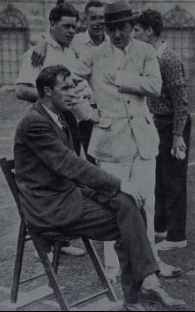
The French finally succeeded in 1927. Lacoste, the brains of the French operation, knew it would take a team effort to topple Tilden. The challengers didn’t expect Cochet to beat Big Bill on the first day–and he didn’t. They didn’t count on defeating Tilden and Frank Hunter in the doubles–and they didn’t. But after Borotra and Brugnon spent five sets running Tilden ragged, the 34-year-old American was ripe for the picking. Lacoste, perhaps the one man on earth who had studied tennis strokes as comprehensively as the American champion, beat Big Bill in four. Cochet brushed aside an over-the-hill Johnston to secure the Cup for France.
The Musketeers held on to the trophy for six years, and the Americans didn’t get it back for more than decade. (By then, Tilden was a professional, and he was coaching another nation’s squad.) But the story doesn’t end there.
A year later, Tilden led his side through the preliminary rounds to take on the French at their new stadium in Paris. The surface favored the hosts, the crowds went only one way, and Big Bill was another year older. Yet in the opening rubber, he beat Lacoste in five sets.
“Two years ago I knew at last how to beat him,” said the Frenchman. “Now, on my own court, he beats me. I never knew how the ball would come off the racket, he concealed it so. I had to wait to see how much it was spinning, and sometimes it didn’t spin at all.”
Big Bill continued to exact his revenge. At Wimbledon in 1930, he beat Borotra in a semi-final that effectively determined the champion. And while Cochet was the only man to maintain a winning record against him as an amateur, Tilden dominated their meetings as professionals.
Lacoste concluded in 1928, “Is he not the greatest player of them all?”
* * *
For decades, the only acceptable answer to that question was Yes.
Fred Perry: “My personal opinion is, when you start talking about great players, you talk of Tilden. And then, about two weeks later, you start talking about the others.”
Bobby Riggs: “I would rank Tilden alone. He is B.C. The others are A.D. You don’t rank him. In the Tilden era who was there? Only Tilden.”
Big Bill finally tired of his fights with the USLTA and turned professional after the 1930 season. He immediately became the best player among that group, winning his first tour against Karel Koželuh, 50 matches to 17. My Elo ratings place him as the top pro from 1931 to 1933. He even rates as the strongest player–amateur or professional–in 1933, when he was 40 years old.
The man who dethroned him was Ellsworth Vines, a big-hitting American 18 years his junior. Even then, Tilden won 9 of their first 20 encounters.
Almost a decade later, Big Bill could still challenge the best players in the world. Approaching his 50th birthday, he remained one of the sport’s most famous figures, and tours were restructured to keep his name on the marquee.
A 1941 tour pitted Tilden against 1938 Grand Slam winner Don Budge. Budge usually remembered their 54-match series as one-way traffic, and he was right as far as that went. Our best records suggest that Big Bill won just seven times.
But wait, said Budge’s friend and doubles partner Gene Mako. “You’re the greatest player in the world, maybe the greatest ever, and you can’t beat a forty-eight-year-old every time? It’s unbelievable. If you ask me for amazing sports stories, I tell you Tilden in his late forties, early fifties.”
In 1943, the veteran crushed the reigning US champion, 22-year-old Ted Schroeder, in an exhibition match. Even after the war, he could outplay Riggs–then the top pro–for a set or two at a time.
The man who once wrote that “tennis is played with the mind” spent three decades proving his point.
* * *
Tilden’s story, as you probably know, has an unhappy ending.
In 1946, he was convicted after a traffic cop caught him having sex with a 14-year-old boy. He served several months in prison, and the rules of his parole made it difficult for him to teach. He was caught again in 1949 and sentenced to another prison term. Four years later, he died, shunned by many of his former friends.
We don’t know when Tilden realized he was gay. We have only the barest hints of what he thought about it. Over the course of his time in the spotlight, he became slightly more open. On some pro tours, he traveled with a personal ball boy–invariably a handsome, teenage blond. Fellow players learned to look the other way. Budge, for one, later claimed he was disgusted by the way Big Bill leered at young men.
Somehow, though, Tilden managed to keep his love interests separate from his protégés. He was always on the lookout for young tennis talent, and he would go to great lengths to develop it. He often took a student or two with him as he toured the country each summer, partnering an inexperienced charge in doubles draws. Yet those young men, every one of them, always denied any improprieties.
Frank Deford, who published a biography of the champion in 1976, saw Tilden as trying to recreate a father-son relationship he never fully experienced. John Olliff, a British player and journalist, believed Big Bill had a “hero complex” and preferred to surround himself with acolytes.
There’s probably some truth in both theories. Underlying it all, Tilden was simply lonely. He was a gay man in a macho sport. He towered so high above the competition that, for years, he had no competition at all.
Big Bill had his own explanation for the time he spent helping young players. “Wish I’d had someone to give me a few pointers,” he told the New Yorker in 1926. “My way would have been easier. I have always had to go it alone.”
* * *
Previous: No. 8, Rafael Nadal
Next: No. 6, Serena Williams
Subscribe to the blog to receive each new post by email:
